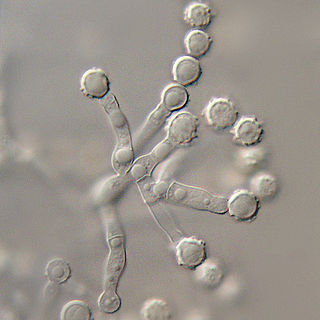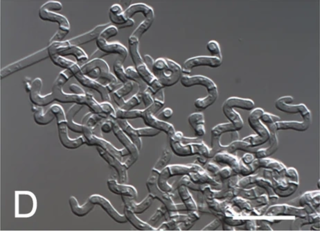Related Research Articles

Eurotiomycetes is a large class of ascomycetes with cleistothecial ascocarps within the subphylum Pezizomycotina, currently containing around 3810 species according to the Catalogue of Life. It is the third largest lichenized class, with more than 1200 lichen species that are mostly bitunicate in the formation of asci. It contains most of the fungi previously known morphologically as "Plectomycetes".

The Hypocreales are an order of fungi within the class Sordariomycetes. In 2008, it was estimated that it contained some 237 genera, and 2647 species in seven families. Since then, a considerable number of further taxa have been identified, including an additional family, the Stachybotryaceae. Wijayawardene et al. in 2020 added more families and genera to the order. According to the Catalog of Life, As of April 2021 the Hypocreales contains 6 families, 137 genera, and 1411 species.

Neurospora is a genus of Ascomycete fungi. The genus name, meaning "nerve spore" refers to the characteristic striations on the spores that resemble axons.
Monascus is a genus of mold. Among the known species of this genus, the red-pigmented Monascus purpureus is among the most important because of its use in the production of certain fermented foods in East Asia, particularly China and Japan.

The order Sordariales is one of the most diverse taxonomic groups within the Sordariomycetes.

The Microascaceae are a family of fungi in the class Sordariomycetes, subclass Hypocreomycetidae. The family was published by David Malloch in 1970, an emended description based on Everet Stanley Luttrell's original 1951 publication. Family was updated in 2020.
Cercophora is a genus of fungi which was within the Lasiosphaeriaceae family. As of 2020, it was placed into the Neoschizotheciaceae family.
Jugulospora is a genus of fungi that was placed within the Lasiosphaeriaceae family, It was then moved into the Neoschizotheciaceae family. This was thought to be a monotypic genus, containing the single species Jugulospora rotula, until more species were found.
Zopfiella is a genus of fungi within the Lasiosphaeriaceae family.
Achaetomium is a genus of fungi within the Chaetomiaceae family.
Thielavia is a genus of fungi in the family Chaetomiaceae. Circumscribed by German botanist Friedrich Wilhelm Zopf in 1876, Thielavia is a teleomorph of Myceliophthora. Collectively, the genus is widely distributed, and according to a 2008 estimate, contained 31 species. Thielavia heterothallica and T. terrestris can cause infections in humans.

The Onygenaceae are a family of fungi in the Ascomycota, class Eurotiomycetes.

Arachnomyces is a genus of cleistothecial ascomycete fungi described in 1902, of which the anamorph (asexual) stage is the genus Onychocola. Although morphologically similar to members of other families, the fungus now belongs to its own monotypic family Arachnomycetaceae, which is the only family in the monotypic order Arachnomycetales.
The Ceratostomataceae are a family of fungi in the phylum Ascomycota, class Sordariomycetes, subclass Hypocreomycetidae and order Coronophorales.
Preussia is a genus of fungi in the family Sporormiaceae. The widespread genus contains 51 species that grow on dung or in the soil.

Purpureocillium is a fungal genus in the Ophiocordycipitaceae family. The genus now contains at least 5 species with the type species Purpureocillium lilacinum, a common saprobic, filamentous fungus. It has been isolated from a wide range of habitats, including cultivated and uncultivated soils, forests, grassland, deserts, estuarine sediments and sewage sludge, and insects. It has also been found in nematode eggs, and occasionally from females of root-knot and cyst nematodes. In addition, it has frequently been detected in the rhizosphere of many crops. The species can grow at a wide range of temperatures – from 8 to 38 °C for a few isolates, with optimal growth in the range 26 to 30 °C. It also has a wide pH tolerance and can grow on a variety of substrates. P. lilacinum has shown promising results for use as a biocontrol agent to control the growth of destructive root-knot nematodes.
The Coniochaeta are a genus of pleomorphic yeasts of the order Coniochaetales and are pathogens of trees. Some species have also been found to form endophytic associations within plants in which they live inside plant tissues but do not actually harm the organism. They can take the form of pink to brown colonies, hyphae, conidiophores or sclerotia. In 2013, the Lecythophora were merged with the Coniochaeta, following suggestions by Ziauddin Khan et al.
Oidiodendron is a genus of fungi in the family Myxotrichaceae. It has 26 species. The genus was circumscribed by Norwegian forester Håkon Robak in 1932, with Oidiodendron fuscum assigned as the type species. The species is now known as Oidiodendron tenuissimum.
Conioscypha is a genus of terrestrial and freshwater fungi in the monotypic family Conioscyphaceae and the monotypic order Conioscyphales. They are found on decayed wood, leaves, or bamboo stems. Except for Conioscypha japonica which was isolated from dog skin fragments and hair in 2017.
References
- ↑ Lumbsch TH, Huhndorf SM. (December 2007). "Outline of Ascomycota – 2007". Myconet. Chicago, USA: The Field Museum, Department of Botany. 13: 1–58.
- 1 2 "Species Fungorum - Search Page - Sphaerodes". www.speciesfungorum.org. Retrieved 15 July 2023.